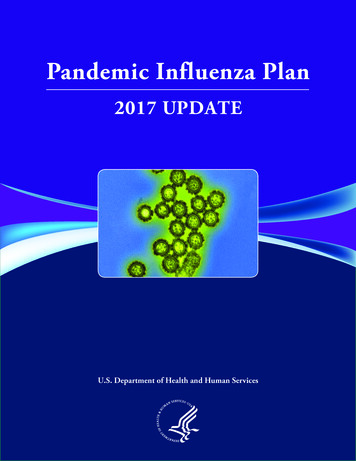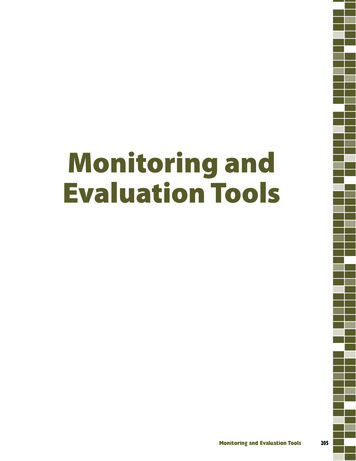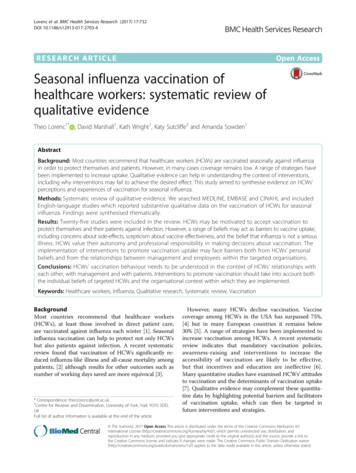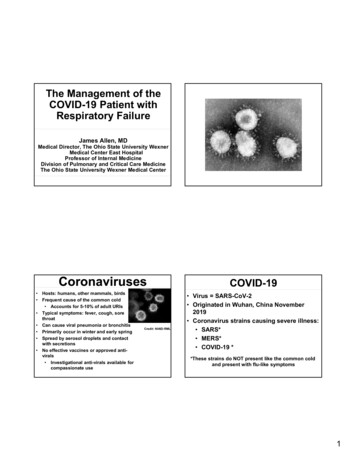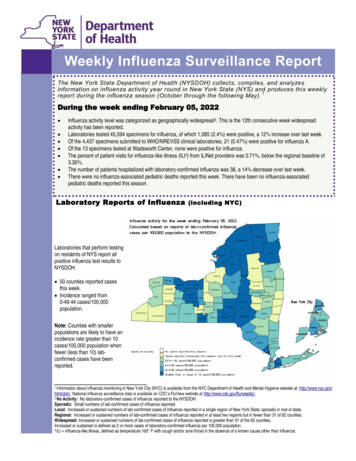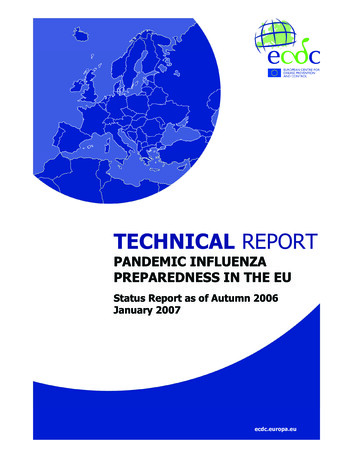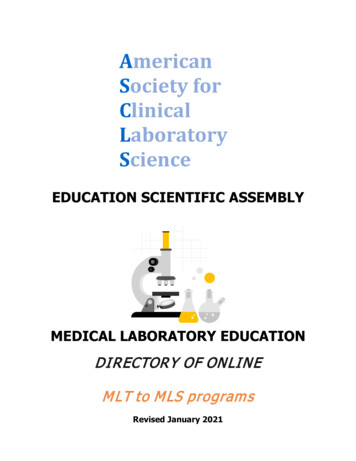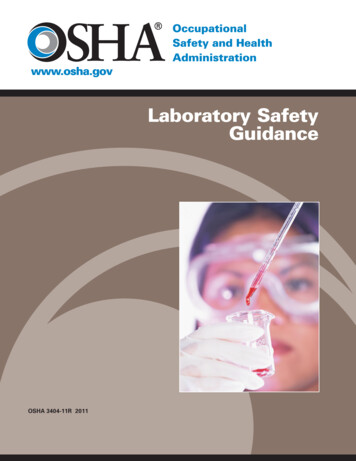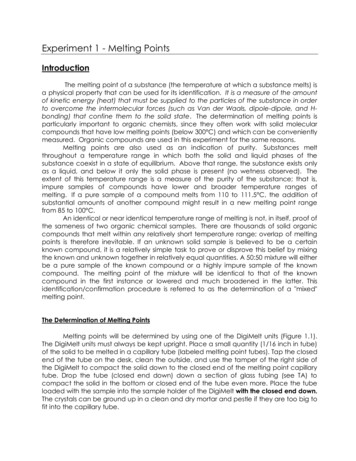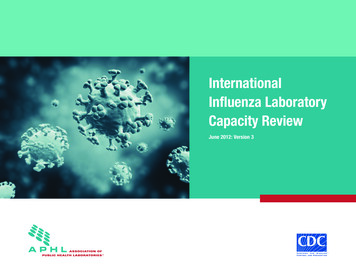
Transcription
InternationalInfluenza LaboratoryCapacity ReviewJune 2012: Version 3
Table of ContentsBackground. 7Laboratory Contact Information.11General Laboratory.17Specimen Handling, Collection, and Reporting.29Virology Laboratory.41Molecular Biology Laboratory.51Laboratory Safety and Biosafety.61Quality Assurance/Quality Control.73Equipment.79Training.87Capacity Report Template.93Acronyms.97Appendix A - Resources. 101Appendix B - Suggested Reagents and Supplies .105Centers for Disease Control and Prevention & Association of Public Health Laboratories. International Influenza Laboratory Capacity Review Version 3.Washington D.C.: Association of Public Health Laboratories; 2012.
Background
Background of the International Influenza Capacity Review ToolThe CDC-APHL International Influenza Laboratory Capacity Review Tool (IILCRT) is a data gathering tool to assesslaboratory capabilities and capacities, with an emphasis on influenza diagnostics. The information collected fromthe tool can be used to identify a laboratory’s strengths and challenges. The capacity review with the IILCRT willbe conducted in the laboratory to assess a wide variety of laboratory aspects. The tool consists of nine modularsections which includen Laboratory Contact Informationn General Laboratoryn Specimen Handling, Collection, and Reportingn Virology Laboratoryn Molecular Biology Laboratoryn Laboratory Safety and Biosafetyn Quality Assurance / Quality Controln Equipmentn TrainingThe modular design of the tool allows for each of the sections described above to be administered independently,and/or by multiple persons if teams are completing the review. The person(s) performing the capacity review, havesignificant experience in virology (specifically influenza), molecular biology, and influenza diagnostics. In addition,the individual(s) performing the capacity review have experience training laboratory staff with the CDC HumanInfluenza Virus Real-Time RT-PCR Detection and Characterization assays.4International Influenza Laboratory Capacity Review Tool
Laboratory ContactInformation
Laboratory Contact Information1Name of LaboratoryPhoneAddressFAXEmailPoint of ContactAlternate Email (yahoo, gmail, etc.)AFR qWPR qAMR qSEAR qEUR qEMR q2Which WHO region is the laboratory located?3Is the laboratory a WHO National Influenza Center (NIC)?q Yesq Noq Do not Know/not sure3aIf No, has the laboratory applied to become a NIC?q Yesq Noq Do not Know/not sure4Which country is this laboratory’s WHO Influenza Reference Laboratory located in?5Which international funding/partner organizations is the laboratory affiliated with (check all that apply)?Pasteur qPAHO6qCDCUSAIDqqWHOqPATH Global HealthWorld BankqqOther (please specify)Shipping Address (If different from mailing address)6International Influenza Laboratory Capacity Review Tool
Laboratory Contact Information7Contact within Ministry of HealthName Phone EmailDoes the contact within the MoH speak English?If Yes, conversational EnglishIf Yes, scientific EnglishIf Yes, fluent EnglishOther spoken languages (please specify)?8q Yesq Yesq Yesq Yesq Yesq Noq Noq Noq Noq NoLaboratory DirectorName Phone EmailDoes the Influenza Laboratory Director speak English?If Yes, conversational EnglishIf Yes, scientific EnglishIf Yes, fluent Englishq Yesq Yesq Yesq Yesq Noq Noq Noq NoOther spoken languages (please specify)?9Laboratory SupervisorName Phone EmailDoes the Influenza Laboratory Director speak English?If Yes, conversational EnglishIf Yes, scientific EnglishIf Yes, fluent Englishq Yesq Yesq Yesq Yesq Noq Noq Noq NoOther spoken languages (please specify)?7International Influenza Laboratory Capacity Review Tool
Laboratory Contact Information10Influenza Laboratory Supervisor (if different from above)Same as Laboratory Supervisor AbovePhoneEmailIf Yes, conversational EnglishIf Yes, scientific EnglishIf Yes, fluent EnglishOther spoken languages (please specify)?128q NoNameDoes the Influenza Laboratory Supervisor speak English?11q Yesq Yesq Yesq Yesq Yesq Noq Noq Noq NoEvaluatorSignatureDate of visitGeneral Comments/Notes:International Influenza Laboratory Capacity Review Tool
General Laboratory
General Laboratory1What is the laboratory’s affiliation/designation?q Ministry of Healthq National Laboratory2q University Laboratoryq Hospital LaboratoryWhat is the primary function of the laboratory?3q Public Health Surveillanceq National Influenza Centerq Researchq Diagnostic/Clinicalq Clinicalq Other (please specify)What surveillance activities does the laboratory participate in (check all that apply)?q Influenza4q HIVq Respiratory Viruses (Other then Influenza)q HIVq TBq Foodborneq Respiratory Viruses5q GIq Other (please specify)MTWThFSaSuWhich days does the laboratory normally operate?How many hours per day does the laboratory normally operate?How many days per year is the laboratory closed for holidays?q 0-5 days10q Other (please specify)What infectious disease testing services does the laboratory provide (check all the apply)?q Influenzaq STD6q Other (please specify)q 5-10 daysq More than 10 daysInternational Influenza Laboratory Capacity Review Tool
General Laboratory7Are there specific months where the laboratory is closed for significant time due to other activities?7aIf Yes, please specify which one(s):q Yes q No8 How many influenza laboratory staff are:910Full-timePart-timeHow many laboratory staff do you have trained to:Full-timeHalf-timePerform influenza virology?Perform influenza molecular biology?Are laboratory staff cross-trained to perform molecular biology and virology?q Yes, all staffq Yes, only select staff membersq Noq Don’t know/not sure11 Please describe the duties of the influenza laboratory staff including:Name11TitleDutiesInternational Influenza Laboratory Capacity Review Tool
General Laboratory12On average, how many hours per week do influenza laboratory staff work on other activities besides influenza testing?13Does the laboratory perform virus isolation?13aIf no, why?14Does the laboratory perform PCR?14aIf no, why?q Yes q Noq Yes q No15 Approximately how many influenza specimens does the laboratory receive for diagnostic testing per week?16Does the laboratory perform any influenza testing from non-human specimens?q Yes q NoIf yes, please describe:12International Influenza Laboratory Capacity Review Tool
General Laboratory17Does the laboratory participate in External Quality Assessment Programs?17aHow many panels did your laboratory complete in the past year?17bIf yes, please provide score(s):DateScore18q Yes q No**Please provide most recent documentationIs there a responsible official for receiving specimens:Time of DayYesNoDon’t know/Not sureIf yes, title of theresponsible officerIf no, who receivesspecimens?During Normal Operating HoursAfter Normal Operating Hours19Does the laboratory have security measures in place?19aIf yes, what are these measures (check all that apply)?q Electronic surveillance (cameras)q Manned surveillanceq Electronic security systemq Front door chain locks13q Yes q Noq ID badgesq Require sign-in of visitorsq Other (please specify)20Does the laboratory have a written biosecurity plan?20aIf no, would you be interested in assistance developing one?q Yesq Yesq Noq NoInternational Influenza Laboratory Capacity Review Tool
General Laboratory21Does the laboratory have biosecurity measures in place (i.e. to prevent internal theft)?21aIf yes, what are these biosecurity measures (check all that apply)?q ID badgesq Freezer locksq Restricted access to buildingsq Yes q Noq Camerasq Restricted access to laboratories (i.e.BSL 3)q Other (please specify)22Does the laboratory have facilities that maintain and care for animals?22aIf yes, what animals, and what is the purpose of the animals?q Yes q No23Does the laboratory appear to be structurally sound (no missing windows, doors, etc.)?24Please indicate the condition of the following in the laboratory:Goodq Yes q NoOKBadNon-ExistingACVentilationLighting2514Does laboratory equipment appear to be placed appropriately given any structural limitations?q Yes q NoInternational Influenza Laboratory Capacity Review Tool
General Laboratory26In an average week, please indicate the percentage of availability for the following utilities:Less then 10%10-50%50-99%100%ElectricityWater26aIs the available electrical capacity sufficient to power all equipment?27Does the laboratory have an emergency generator/power supply?27aIf yes, do you routinely check its operational status?28Are critical equipment (PCR machines, freezers, etc.) connected to UPS battery backups?28aIf yes, do you routinely check its operational status?28bIf yes, please indicate voltage capacity:q Yes q Noq Yes q Noq Yes q Noq Yes q Noq Yes q Noq 220Vq 110Vq Do not know1529Is the laboratory supported by maintenance staff?29aIf yes, what type of staff (check all that apply):q Other (please specify)q Yes q Noq Plumberq Electricianq MechanicalInternational Influenza Laboratory Capacity Review Tool
General LaboratoryLaboratory Response30Has the laboratory obtained information concerning the WHO International Health Regulations?30aDoes your laboratory have contact information for the Ministry of Health’s IHR focal point?30bIf yes, what is the contact process?31Does the laboratory have a crisis plan that can be instituted during an emergency (e.g. national disaster, pandemic)?q Yes q Noq Yes q Noq Yes q No31aIf no, are you interested in developing one?32Is there a 24 hour, 7 day emergency contact, in case of critical equipment failure or disease outbreaks?q Yes q Noq Yes q No1632aIf yes, what is their job title?33Is the laboratory part of any committee related to public health event management?34Is the laboratory part of a working group for influenza outbreak investigation?35Did you participate in any influenza field or outbreak investigations during the past year?q Yes q Noq Yes q Noq Yes q NoInternational Influenza Laboratory Capacity Review Tool
General LaboratoryInfluenza Testing Algorithm36Please provide a brief description of the laboratory’s algorithm for culturing specimens.*Please attach a schematic outline of the laboratory’s algorithmIs the laboratory’s algorithm acceptable?37q Recommendation q AcceptableWhat are the top three parameters for altering the seasonal influenza algorithm?1.2.3.38Please provide a brief description of the laboratory’s protocol/algorithm for the unsubtypable influenza A specimens.*Please attach a schematic outline of the laboratory’s algorithmIs the laboratory’s protocol/algorithm acceptable?17q Recommendation q AcceptableInternational Influenza Laboratory Capacity Review Tool
General Laboratory39Does the laboratory have a written plan to address influenza surge capacity activities?q Yes q NoIf yes, briefly describe:39aIf no, is the laboratory interested in assistance for developing one?40General Comments/Notes:q Yes q No18International Influenza Laboratory Capacity Review Tool
Specimen Handling,Collecting, and Reporting
Specimen Handling, Collecting, and Reporting11aDoes the laboratory have written procedures for influenza specimen:Collection?q Yesq NoLogging?q Yesq NoTransport?q Yesq NoProcessing?q Yesq NoLabeling?q Yesq NoStorage?q Yesq NoShipping?q Yes q NoWhat is the laboratory’s policy for shipping infectious substances to WHO, NIC, or other reference laboratories?Is the laboratory’s policy for shipping influenza specimens acceptable?2What type of Viral Transport Medium (VTM) is used?q WHO VTMq Commercial VTM320q Universal Transport mediumq Other VTM (please describe)What types of influenza specimens does the laboratory accept (check all that apply)?q Nasopharyngeal swabsq Nasopharyngeal washesq Nasopharyngeal aspiratesq Nasal swabs4q Recommendation q Acceptableq Throat swabsq Dual nasopharyngeal swabs/ throat swabsq Serumq Other (please describe)Is an influenza like illness or severe acute respiratory infection case definition used in selecting patients for specimen collection?q Yes q NoInternational Influenza Laboratory Capacity Review Tool
Specimen Handling, Collecting, and ReportingInfluenza Specimen Receiving5Who sends influenza specimens to your laboratory (check all that apply)?q Sentinel providersq Out reach clinicsq Hospital facilities6How are influenza specimens triaged (check all that apply)?q All tested7q Clinical laboratoriesq Physician officesq Other (please describe)q Subset are testedq Other (please specify)Please describe the quality control measures done to make sure the cold chain was maintained.21International Influenza Laboratory Capacity Review Tool
Specimen Handling, Collecting, and Reporting8How are influenza specimens stored at the sentinel surveillance sites?Cold StorageNormal HoursY/NAfter HoursHow Long?How Long?Refrigeration (2ºC to 8ºC)Freezer ( -20 ºC)Freezer ( -70ºC to -80ºC)Other (please specify)Is the storage of influenza specimens at sentinel surveillance sites acceptable?8aq Recommendation q AcceptableHow are influenza specimens stored prior to laboratory testing?Cold StorageNormal HoursY/NAfter HoursHow Long?How Long?Refrigeration (2ºC to 8ºC)Freezer ( -20 ºC)Freezer ( -70ºC to -80ºC)Other (please specify)Is the storage of influenza specimens prior to laboratory testing acceptable?9Is there a designated area within influenza for receiving specimens?10Do you encounter the following problems when receiving samples:q Recommendation q Acceptableq Yes q NoAlwaysSometimesNeverWrongly packaged?Wrong temperature?Wrong identification?Delay in sample delivery?22International Influenza Laboratory Capacity Review Tool
Specimen Handling, Collecting, and Reporting11Does the laboratory provide a unique identifier for all influenza specimens?12Are influenza specimens aliquoted before being frozen?q Yes q No13Does the laboratory have written criteria for influenza specimen rejection?q Yes q No13aIf yes, please specify:q Yes q No14What original clinical specimens does the laboratory retain for at least a year (check all that apply):q All specimensq Only specimens testing positiveq Only specimens testing negative14aq Specimens testing both positive/negativeq All inconclusive specimensIf influenza specimens cannot be retained, why?Is the retention of specimens acceptable?23q Recommendation q AcceptableInternational Influenza Laboratory Capacity Review Tool
Specimen Handling, Collecting, and ReportingInfluenza Specimen Reporting15Please indicate who receives your laboratory’s specimen results:Reporting MethodsElectronicFaxPhoneOther(please specify)Frequency(e.g. daily,weekly,monthly)Turn around timefrom receipt of specimen (e.g. 24 hrs,24hrs, 48hrs, 1 week)WHO FluNetMinistry of HealthSpecimenSubmitterOther (please specify):Is the laboratory’s reporting acceptable?16Does the laboratory have reliable connectivity to report out results (cell phones, landlines, internet)?17How often are summary reports generated?q Daily24q Recommendation q Acceptableq Weeklyq Monthlyq Yes q Noq Other (please specify)International Influenza Laboratory Capacity Review Tool
Specimen Handling, Collecting, and Reporting18Does the laboratory use standardized forms to report results?q Yes q No*Please provide a copy of the laboratory’s standard reporting form19Does the laboratory staff know what the reporting requirements are under the International Health Regulations (IHR)?q Yes q No20Do test results undergo internal review prior to reporting out?20aIf yes or sometimes, briefly describe the internal review process.q Yesq Noq Sometimes21Is there a written policy for rapid notification of reportable influenza cases?21aIf yes, please describe:q Yes q No25International Influenza Laboratory Capacity Review Tool
Specimen Handling, Collecting, and ReportingInfluenza Specimen Records22Does your laboratory maintain records of reported results?22aIf yes, how long?23What methods are used to archive reported results?q Yes q No23aIf archived electronically, how are the records backed up?24Is there restricted access to archived records?24aIf yes, who has access?q Yes q NoInfluenza Specimen Shipping25How many times a year are virus isolates or rt-PCR positive specimens sent to WHO (collaborating center or NIC)?25aWhich WHO collaborating center does the laboratory send isolates or RNA postitive specimens to?*Please provide additional information regarding specimen shipping in the table at the end of this section.Is the laboratory’s shipping frequency acceptable?26q Recommendation q AcceptableInternational Influenza Laboratory Capacity Review Tool
Specimen Handling, Collecting, and Reporting26Are influenza specimens sent for:26aConfirmation?q Yes q NoIf yes, how often are batches sent?26bFurther characterization?q Yes q NoIf yes, how often are batches sent?27How does the laboratory track influenza specimens sent to reference laboratories?q Lab information management system (LIMS)q Software programs installed on computers (i.e. Microsoft Excel)q Notebook / binder28q Other (please describe)How are isolates chosen for shipping to WHO CC (e.g. age, geographically, etc)?Is the selection of isolates acceptable?27q Recommendation q Acceptable29What shipper(s) are located in country?29aWhich vendor is the preferred shipper (e.g. World Courier)?29bDoes the shipper perform packaging (e.g. World Courier)?q Yes q NoInternational Influenza Laboratory Capacity Review Tool
Specimen Handling, Collecting, and Reporting30Does the laboratory experience any problems or difficulties with customs?30aIf yes, please explain:q Yes q NoTraining31Is internal training offered for staff on:Specimen collection transport and labeling?Specimen receiving?Shipping infectious substances?31aq Yes q Noq Yes q Noq Yes q NoWhat topics are covered during training (e.g. specimen storage prior to collection, specimen packaging for transport, labeling, logging,processing, storage)?*Please provide additional information in the training table32General comments/notes regarding specimens:28International Influenza Laboratory Capacity Review Tool
Specimen Handling, Collecting, and ReportingSpecimenPlease indicate the number of specimens for each of the following and where they were shippedwithin the past year for your laboratory:AMonth29YearPandemicA(H1)A To WHOCC in:AustraliaJapanUSUKChinaInternational Influenza Laboratory Capacity Review Tool
Virology Laboratory
Virology Laboratory1Please indicate what influenza testing methods your virology laboratory currently performs.Current Direct Detection MethodsVirus an Influenza A/H1Human Influenza A/H3Human Influenza B2009 AH1N1pdmH5 Avian InfluenzaHigh PathogenicAvian InfluenzaLow Pathogenic AvianInfluenzaOther Avian InfluenzaOther (please specify):31International Influenza Laboratory Capacity Review Tool
Virology Laboratory2Does the laboratory perform isolation for viruses other than influenza?Virus IsolationVirus TypeYesNoRespiratory syncytial virus (RSV)CoronavirusAdenovirusParainfluenza (HPIV)RhinovirusPicornavirusMetapneumovirus (MPV)MeaslesOther (non-influenza e.g. dengue, rotavirus) please specify:*If your laboratory performs virus isolation, please provide additional information in the table at the end of this section.3Does the laboratory assign strain designations to influenza viruses?3aIf yes, please describe which nomenclature is used (e.g. WHO criteria):q Yes q No32International Influenza Laboratory Capacity Review Tool
Virology Laboratory4If your laboratory is performing immunofluorescence testing please indicate kit and source.Kit and Sourceq DFAq IFA5Does the laboratory perform haemagglutination inhibition testing (HAI)?5aIf yes, does the laboratory use the WHO reagent kit?5bIf yes, from which WHO Center?5cIf yes, what is the laboratory’s main source of red blood cells:q Yes q Noq Yes q NoAnimalVendor / Source6Is there virology research conducted in the same laboratory as diagnostic testing?q Yesq NoInfluenza Virus Culture733How much experience does the laboratory have performing influenza virus culture?q 6 monthsq 6 - 12 monthsq 12 monthsInternational Influenza Laboratory Capacity Review Tool
Virology Laboratory8Does the laboratory use cell culture, eggs, or both?q Cell CultureCell Lineq EggsSourceq BothQC Testing for Mycoplasma sp.performed (Y/N)Does the laboratory perform quality control testing for Mycoplasma on all cell lines? If yes, please check acceptable.q Recommendation q Acceptable9Under normal operating conditions, how often are influenza specimens cultured during peak influenza season?q Dailyq Weeklyq Monthlyq Other (please specify)Is the frequency of culturing specimens during peak influenza season acceptable?10Approximately what percent of RT-PCR positive influenza specimens are cultured?q Less then 10%11q 10-20%q 20-30%q 30-40%q 40-50%q Greater than 50%What types of vessels are used for cell culture (check all that apply)?q Flasks34q Recommendation q Acceptableq Tubesq Shell vialsq Other (please specify)International Influenza Laboratory Capacity Review Tool
Virology Laboratory12Is there a designated clean room for cell culture?12aIf no, where do you perform cell culture?12bIf no, how do you prevent contamination?q Yesq NoContamination Control13Does the virology laboratory have a protocol to monitor contamination?13aIf yes, please describe:q Yes q No1435In the virology laboratory, is there task-specific dedication and separation of:Pipettesq Yesq NoPPEq Yesq NoInstrumentationq Yesq NoEquipmentq Yesq NoSuppliesq Yesq NoReagentsq Yesq NoInternational Influenza Laboratory Capacity Review Tool
Virology Laboratory1516Are there separate Biosafety Cabinets (BSCs) designated for influenza virology:Cell cultureq Yes q NoVirus isolationq Yes q NoAvian influenza (i.e. H5N1)q Yes q NoNon-human influenzaq Yes q NoDoes the virology laboratory have a designated shelf or space for:ProductsFreezer (Y/N)Refrigerator (Y/N)ReagentsControlsArchived influenza specimensVirology Quality Assurance3617Does the laboratory have written quality control virology procedures?17aAre the procedures updated regularly?18Does the laboratory quality control all reagents and standards used for virology procedures?19Are critical reagents stored properly (antibiotics at @ 2ºC to 8ºC, BCS at -20ºC) for virology procedures?q Yes q Noq Yes q No q Do not Know/not sureq Yes q Noq Yes q NoInternational Influenza Laboratory Capacity Review Tool
Virology LaboratoryVirology Training20Is internal training offered for virology staff on virology methods?20aWhat topics are covered during training (e.g. cell culture)?q Yes q No*Please provide additional information in the training table21General comments/notes regarding virology:37International Influenza Laboratory Capacity Review Tool
Virology LaboratoryVirus IsolationIs the frequency of virus isolation activity acceptable?q Recommendation q AcceptablePlease estimate the number of strains your laboratory isolated within the past 2 years:Date(mm/yyyy)38No. of SpecimenCollectedProcessedNo. of strains isolatedA (not- subtyped)A(H1)Pandemic A(H1)A(H3)BUnidentifiedOther (specify)International Influenza Laboratory Capacity Review Tool
Molecular Biology Laboratory
Molecular Biology Laboratory1Please indicate what influenza testing methods your molecular biology laboratory currently performs.Current Direct Detection MethodsVirus TypeRT-PCRConventionalPCRAntiviralTestingRapid InfluenzaDiagnosticTestsOtherHuman Influenza A/H1Human Influenza A/H3Human Influenza B2009 AH1N1pdmH5 Avian InfluenzaHigh Pathogenic Avian InfluenzaLow Pathogenic Avian InfluenzaOther Avian InfluenzaOther influenza viruses (please specify below):2Approximately how many influenza specimens can the laboratory staff process per week by RT-PCR?q Less than 540q 5-10q 10-15q 15-20q Greater than 20q Other (please specify):International Influenza Laboratory Capacity Review Tool
Molecular Biology Laboratory2aUnder normal operating conditions:Is your laboratory able to process all specimens within 1 week of receiving them?q Yes q NoHow many RT-PCR runs can the laboratory execute per day?How many specimens can be subtyped per day?What percent of your specimens are positive for influenza A?3If the influenza laboratory is performing Real Time (RT-PCR) and Conventional PCR, which kit(s) and manufacturer are used?4Please describe how each diagnostic RT-PCR run is set up (e.g. review SOP and describe plate set up, controls, etc.):*Please provide Standard Operating Procedure for RT-PCR.415Does your molecular biology laboratory have a designated area for PCR set up?6Does the laboratory have a uni-directional workflow (pre-amplification to post-amplification) for PCR?6aIf no, why?q Yes q Noq Yes q NoInternational Influenza Laboratory Capacity Review Tool
Molecular Biology Laboratory7Is there a designated area for handling RNA?8What method does the laboratory currently use for RNA isolation / purification?8aIf a kit is employed to purify RNA, please identify which kit and the manufacturer.9What specific primers and probes are the laboratory using for influenza testing (e.g. source/manufacturer/other)?q Yes q NoSeasonal/Novel InfluenzaAvian InfluenzaOther10Does the laboratory use any system for internal quality control?10aIf yes, please describe:q Yes q No4211Are internal controls included in each test run?11aIf Yes, is the performance of these internal controls recorded and monitored over time?11bIf Yes, is there acceptance / rejection criteria?q Yes q Noq Yes q Noq Yes q NoInternational Influenza Laboratory Capacity Review Tool
Molecular Biology Laboratory12Does the laboratory have a reliable source for RT-PCR reagents and supplies?12aIf yes please identify the reagents (e.g. superscript, extractions kits, etc) and the sources (e.g. CDC, WHO, Manufacturer, etc.).Reagentq Yes q NoSource12bDoes the laboratory have difficulty procuring reagents?12cIf yes, which reagents and why?q Yes q NoSequencing13Does the laboratory perform influenza sequencing?13aIf yes, where is the sequence data deposited?q GISAIDq GenBankq Yes q Noq Other (please specify):Does the laboratory use an acceptable method for reporting sequence data?43q Not reportedq Recommendation q AcceptableInternational Influenza Laboratory Capacity Review Tool
Molecular Biology Laboratory14Does the laboratory perform influenza phylogenetic analyses?14aIf yes, please explain:q Yes q NoStorage and Contamination Control15Does the molecular biology laboratory have a protocol to monitor contamination?15aIf Yes, please describe:16Is there a designated area for handling post-PCR amplified product?17In the molecular biology laboratory, is there task-specific dedication and separation of:18q Yes q Noq Yes q NoPipettesq Yesq NoEquipmentq Yesq NoPPEq Yesq NoSuppliesq Yesq NoInstrumentationq Yesq NoReagentsq Yesq NoAre any of the following dedicated for pre-PCR use only?q Pipettesq Personal protective equipment (PPE)q Suppliesq Reagentsq Centrifugesq Other (please specify)44International Influenza Laboratory Capacity Review Tool
Molecular Biology Laboratory19Does the molecular biology laboratory have a designated shelf or space for:ProductsFreezer (Y/N)Refrigerator (Y/N)Influenza molecular reagentsInfluenza positive controlArchived influenza specimens20Are critical reagents (i.e. enzymes) stored in frost free freezers?20aIf yes, is the automatic defrost disabled?q Yes q Noq Yes q NoMolecular Quality Assurance21Does the laboratory have written quality control molecular procedures?21aIf yes, are the procedures updated regularly?22Does the laboratory quality control all reagents and standards used for molecular procedures?23Are critical reagents stored properly (enzymes @ -20ºC, buffers @ 2ºC to 8ºC, etc.) for molecular procedures?q Yes q Noq Yes q Noq Yes q Noq Yes q No45International Influenza Laboratory Capacity Review Tool
Molecular Biology LaboratoryMolecular Biology Training24Is internal training offered for molecular biology staff on laboratory methods?24aWhat topics are covered during training? (e.g. PCR, Nucleic Acid Extraction):q Yes q No*Please provide additional information in the training table25General comments/notes regarding molecular biology:46International Influenza Laboratory Capacity Review Tool
Laboratory Biosafetyand Safety
Laboratory Biosafety and Safety1Does the facility have a designated safety team?q Yesq No1aIf yes, does the influenza laboratory have a member?q Yesq No1bIs there a safety officer for the influenza laboratory?q Yesq No2Does the laboratory have a safety manual?q Yesq No2aIf yes
37 What are the top three parameters for altering the seasonal influenza algorithm? 1. _ 2. _ 3. _ 38 Please provide a brief description of the laboratory's protocol/algorithm for the unsubtypable influenza A specimens. *Please attach a schematic outline of the laboratory's algorithm
